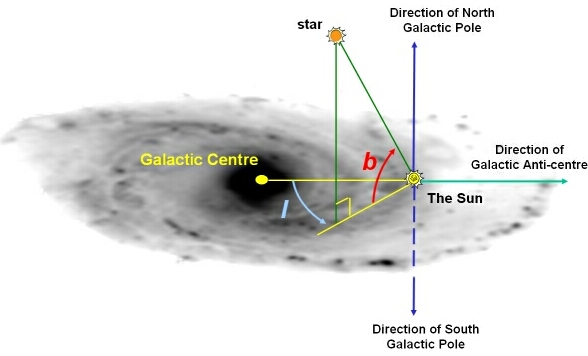Galactic Coordinate System
The galactic coordinate system locates objects within the Milky Way galaxy by ‘latitude’ and ‘longitude’ in a similar manner to Right Ascension and Declination in the equatorial coordinate system. The current definition of the galactic coordinate system was finalised by the IAU in 1959.
The galactic plane, or galactic equator, is similar to the celestial equator of the equatorial coordinate system. It is the great circle of the celestial sphere made by the plane of the disk of our Galaxy.

The system defines a sphere enclosing the galaxy, with the Sun at its centre, onto which galactic latitude (b) and longitude (l) are projected. Galactic latitude ranges from -90° to +90° (below and above the galactic plane respectively), and galactic longitude ranges from 0° to 360°. The galactic longitude l of an object is the angular distance around the Galactic equator from the Galactic centre at l = 0⁰ (towards the constellation Sagittarius) to the object. As for right ascension in the equatorial coordinate system, galactic longitude increases counter-clockwise as viewed looking down from the north galactic pole.
The galactic north pole is at RA = 12h 51.4m, Dec = +27⁰ 07’ (2000.0), the galactic centre at RA = 17h 45.6m, Dec = -28⁰ 56’ (2000.0). The inclination of the galactic equator to Earth’s equator is 63⁰.
Study Astronomy Online at Swinburne University
All material is © Swinburne University of Technology except where indicated.

